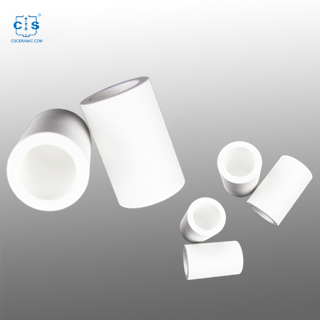Boron Nitride Crucibles
———— Properties and Uses
Boron nitride crucibles are a type of ceramic crucible that are highly sought after in various industries. They are known for their exceptional thermal shock resistance, high-temperature stability, and low wettability. In this article, we will discuss the properties and uses of boron nitride crucibles in detail.

Table of Contents
- Introduction
- What are boron nitride crucibles?
- Properties of boron nitride crucibles
- Thermal shock resistance
- High-temperature stability
- Low wettability
- Chemical resistance
- Electrical insulation
- Production methods for boron nitride crucibles
- Applications of boron nitride crucibles
- Semiconductors
- High-temperature metallurgy
- Chemical synthesis
- Aerospace
- Medical research
- Advantages and disadvantages of boron nitride crucibles
- Maintenance and handling of boron nitride crucibles
- Conclusion
- FAQs
What are boron nitride crucibles?
Boron nitride (BN) is a synthetic compound made up of boron and nitrogen atoms. It is a white solid that resembles graphite in appearance and structure. Boron nitride crucibles are made by molding and sintering boron nitride powder at high temperatures. They are often used in high-temperature applications due to their excellent thermal stability and chemical resistance.
Properties of boron nitride crucibles
Thermal shock resistance
Boron nitride crucibles have exceptional thermal shock resistance. They can withstand sudden changes in temperature without cracking or breaking. This property makes them ideal for use in high-temperature applications where rapid temperature changes are common.
High-temperature stability
Boron nitride crucibles can withstand high temperatures up to 2800°C in an inert atmosphere. This makes them ideal for use in applications that require high-temperature stability.
Low wettability
Boron nitride crucibles have low wettability, which means they do not react with many molten metals, including aluminum, copper, and silver. This property makes them ideal for use in applications that involve the melting of these metals.
Chemical resistance
Boron nitride crucibles are resistant to many chemicals, including acids, bases, and molten metals. This property makes them ideal for use in chemical synthesis applications.
Electrical insulation
Boron nitride crucibles are excellent electrical insulators, making them ideal for use in electronic and semiconductor applications.
Production methods for boron nitride crucibles
Boron nitride crucibles are made using one of two production methods: hot pressing or sintering. In the hot pressing method, boron nitride powder is pressed at high temperatures and pressures to form a solid. In the sintering method, boron nitride powder is mixed with a binder and then molded into the desired shape. The molded crucible is then sintered at high temperatures to form a solid.
Applications of boron nitride crucibles
Semiconductors
Boron nitride crucibles are widely used in the semiconductor industry for crystal growth and other high-temperature processes. They are ideal for use in these applications due to their excellent thermal stability and low wettability.
High-temperature metallurgy
Boron nitride crucibles are used in high-temperature metallurgy applications, including the melting of aluminum, copper, and silver. They are preferred over other types of crucibles due to their low reactivity with these metals.
Chemical synthesis
Boron nitride crucibles are used in chemical synthesis applications, including the synthesis of advanced materials and the production of high-purity chemicals. They arepreferred over other types of crucibles due to their chemical resistance and low wettability, which helps to prevent contamination of the synthesized products.
Aerospace
Boron nitride crucibles are used in aerospace applications for the production of high-temperature components, such as rocket nozzles and thermal protection systems. They are ideal for use in these applications due to their excellent thermal stability and low wettability.
Medical research
Boron nitride crucibles are used in medical research for the production of high-purity materials and the synthesis of advanced compounds. They are preferred over other types of crucibles due to their chemical resistance and low wettability, which helps to prevent contamination of the synthesized products.
Advantages and disadvantages of boron nitride crucibles
Advantages
- Exceptional thermal shock resistance
- High-temperature stability
- Low wettability
- Chemical resistance
- Electrical insulation
- Wide range of applications
Disadvantages
- High cost
- Brittle and prone to cracking
- Limited to use in inert atmospheres
Maintenance and handling of boron nitride crucibles
To ensure the longevity of boron nitride crucibles, proper handling and maintenance are essential. They should be handled with care to prevent cracking or chipping. Before use, they should be cleaned to remove any contaminants or impurities that may affect their performance. Boron nitride crucibles should also be stored in a dry, cool place to prevent moisture absorption.
Conclusion
Boron nitride crucibles are a versatile and highly sought-after type of ceramic crucible. They are known for their exceptional thermal shock resistance, high-temperature stability, and low wettability. Boron nitride crucibles are used in a wide range of applications, including semiconductors, high-temperature metallurgy, chemical synthesis, aerospace, and medical research. While they have several advantages, including excellent chemical resistance and electrical insulation, they also have some disadvantages, including high cost and brittleness. Proper handling and maintenance are essential to ensure the longevity of boron nitride crucibles.
FAQs
1. What is the cost of boron nitride crucibles?
- Boron nitride crucibles can be expensive, with prices ranging from a few hundred to several thousand dollars.
2. Can boron nitride crucibles be used in reactive atmospheres?
- No, boron nitride crucibles are limited to use in inert atmospheres.
3. What is the maximum temperature that boron nitride crucibles can withstand?
- Boron nitride crucibles can withstand temperatures up to 2800°C in an inert atmosphere.
4. Can boron nitride crucibles be reused?
- Yes, boron nitride crucibles can be reused multiple times with proper handling and maintenance.
5. Are boron nitride crucibles compatible with all molten metals?
- No, boron nitride crucibles are compatible with some molten metals, including aluminum, copper, and silver, but not all metals.
Thank you for reading. We invite you to visit CSCERAMIC for more information if you would like to learn more about industrial ceramic material and the advanced range of ceramic products we offer.




 info@csceramic.com
info@csceramic.com







 +86 18273288522
+86 18273288522